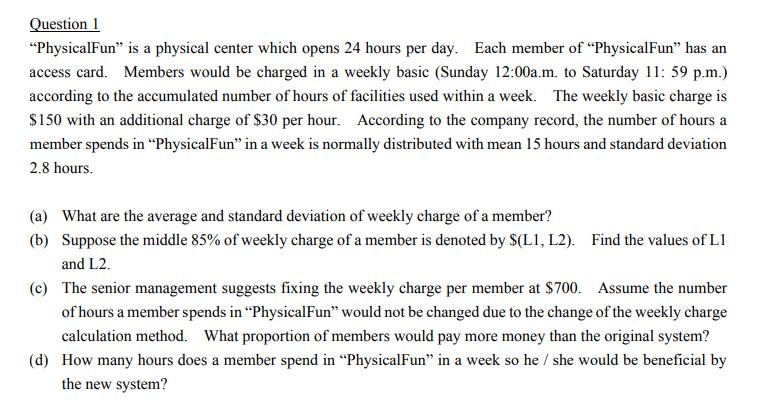
MATLAB: An Introduction with Applications
6th Edition
ISBN: 9781119256830
Author: Amos Gilat
Publisher: John Wiley & Sons Inc
expand_more
expand_more
format_list_bulleted
Question
I do not how to do it

Transcribed Image Text:"PhysicalFun" is a physical center which opens 24 hours per day. Each member of "PhysicalFun" has an
access card. Members would be charged in a weekly basic (Sunday 12:00a.m. to Saturday 11: 59 p.m.)
according to the accumulated number of hours of facilities used within a week. The weekly basic charge is
$150 with an additional charge of $30 per hour. According to the company record, the number of hours a
member spends in "PhysicalFun" in a week is normally distributed with mean 15 hours and standard deviation
2.8 hours.
(a) What are the average and standard deviation of weekly charge of a member?
(b) Suppose the middle 85% of weekly charge of a member is denoted by $(L1, L2). Find the values of L1
and L2.
(c) The senior management suggests fixing the weekly charge per member at $700. Assume the number
of hours a member spends in "Physical Fun" would not be changed due to the change of the weekly charge
calculation method. What proportion of members would pay more money than the original system?

Transcribed Image Text:Question 2
The Body Mass Index (BMI) is a value calculated based on the weight and the height of an individual. In a
small European city, a survey was conducted one year ago to review the BMI of the citizens. In the sample
with 200 citizens, the mean BMI was 23.3 kg/m? and standard deviation was 1.5 kg/m?. It is reasonable to
assume the BMI distribution is a normal distribution.
(a) Find the point estimate of the population mean BMI one year ago.
(b) Calculate the sampling error at 90% confidence.
(c) Construct a 90% confidence interval estimate of the population mean BMI one year ago.
This city launched a healthy exercise program to reduce citizen's BMI after last year's survey. Suppose the
program effectively reduces the BMI of each citizen by 2.5%.
(d) Construct a 98% confidence interval estimate of the population mean BMI after the healthy exercise
program. (Hint: find the updated sample mean and sample standard deviation of the BMI of the sample
with 200 citizens selected last year)
Expert Solution
This question has been solved!
Explore an expertly crafted, step-by-step solution for a thorough understanding of key concepts.
This is a popular solution
Trending nowThis is a popular solution!
Step by stepSolved in 4 steps

Knowledge Booster
Learn more about
Need a deep-dive on the concept behind this application? Look no further. Learn more about this topic, statistics and related others by exploring similar questions and additional content below.Similar questions
arrow_back_ios
arrow_forward_ios
Recommended textbooks for you
 MATLAB: An Introduction with ApplicationsStatisticsISBN:9781119256830Author:Amos GilatPublisher:John Wiley & Sons Inc
MATLAB: An Introduction with ApplicationsStatisticsISBN:9781119256830Author:Amos GilatPublisher:John Wiley & Sons Inc Probability and Statistics for Engineering and th...StatisticsISBN:9781305251809Author:Jay L. DevorePublisher:Cengage Learning
Probability and Statistics for Engineering and th...StatisticsISBN:9781305251809Author:Jay L. DevorePublisher:Cengage Learning Statistics for The Behavioral Sciences (MindTap C...StatisticsISBN:9781305504912Author:Frederick J Gravetter, Larry B. WallnauPublisher:Cengage Learning
Statistics for The Behavioral Sciences (MindTap C...StatisticsISBN:9781305504912Author:Frederick J Gravetter, Larry B. WallnauPublisher:Cengage Learning Elementary Statistics: Picturing the World (7th E...StatisticsISBN:9780134683416Author:Ron Larson, Betsy FarberPublisher:PEARSON
Elementary Statistics: Picturing the World (7th E...StatisticsISBN:9780134683416Author:Ron Larson, Betsy FarberPublisher:PEARSON The Basic Practice of StatisticsStatisticsISBN:9781319042578Author:David S. Moore, William I. Notz, Michael A. FlignerPublisher:W. H. Freeman
The Basic Practice of StatisticsStatisticsISBN:9781319042578Author:David S. Moore, William I. Notz, Michael A. FlignerPublisher:W. H. Freeman Introduction to the Practice of StatisticsStatisticsISBN:9781319013387Author:David S. Moore, George P. McCabe, Bruce A. CraigPublisher:W. H. Freeman
Introduction to the Practice of StatisticsStatisticsISBN:9781319013387Author:David S. Moore, George P. McCabe, Bruce A. CraigPublisher:W. H. Freeman

MATLAB: An Introduction with Applications
Statistics
ISBN:9781119256830
Author:Amos Gilat
Publisher:John Wiley & Sons Inc

Probability and Statistics for Engineering and th...
Statistics
ISBN:9781305251809
Author:Jay L. Devore
Publisher:Cengage Learning

Statistics for The Behavioral Sciences (MindTap C...
Statistics
ISBN:9781305504912
Author:Frederick J Gravetter, Larry B. Wallnau
Publisher:Cengage Learning

Elementary Statistics: Picturing the World (7th E...
Statistics
ISBN:9780134683416
Author:Ron Larson, Betsy Farber
Publisher:PEARSON

The Basic Practice of Statistics
Statistics
ISBN:9781319042578
Author:David S. Moore, William I. Notz, Michael A. Fligner
Publisher:W. H. Freeman

Introduction to the Practice of Statistics
Statistics
ISBN:9781319013387
Author:David S. Moore, George P. McCabe, Bruce A. Craig
Publisher:W. H. Freeman